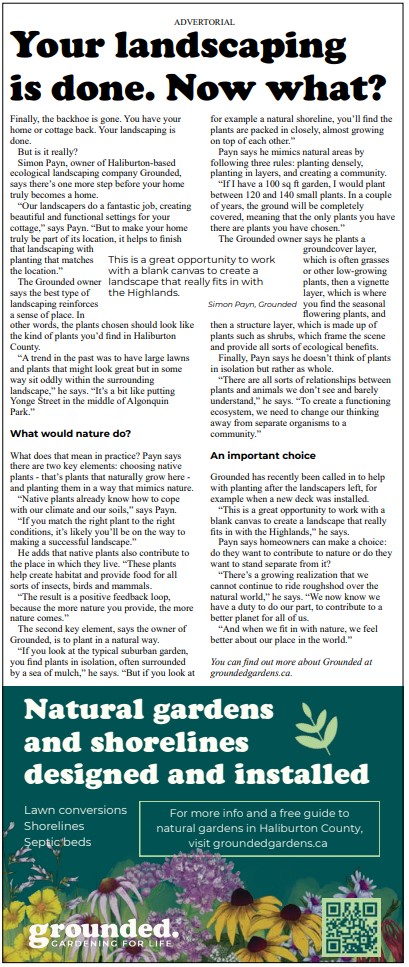
Your cottage landscaping is done. Now what?
Here is an advertorial about using native plants in Haliburton cottage landscaping published in the June 27, 2024 issue of The Highlander.
Finally, the backhoe is gone. You have your home or cottage back. Your landscaping is done.
But is it really?
Simon Payn, owner of Haliburton-based ecological landscaping company Grounded, says there’s one more step before your home truly becomes a home.
“Our cottage landscapers do a fantastic job, creating beautiful and functional settings for your cottage,” says Payn. “But to make your home truly be part of its location, it helps to finish that landscaping with planting that matches the location.”
The Grounded owner says the best type of cottage landscaping reinforces a sense of place. In other words, the plants chosen should look like the kind of plants you’d find in Haliburton County.
“A trend in the past was to have large lawns and plants that might look great but in some way sit oddly within the surrounding landscape,” he says. “It’s a bit like putting Yonge Street in the middle of Algonquin Park.”
What would nature do?
What does that mean in practice? Payn says there are two key elements: choosing native plants – that’s plants that naturally grow here – and planting them in a way that mimics nature.
“Native plants already know how to cope with our climate and our soils,” says Payn.
“If you match the right plant to the right conditions, it’s likely you’ll be on the way to making a successful landscape.”
He adds that native plants also contribute to the place in which they live. “These plants help create habitat and provide food for all sorts of insects, birds and mammals.
“The result is a positive feedback loop, because the more nature you provide, the more nature comes.”
The second key element, says the owner of Grounded, is to plant in a natural way.
“If you look at the typical suburban garden, you find plants in isolation, often surrounded by a sea of mulch,” he says. “But if you look at for example a natural shoreline, you’ll find the plants are packed in closely, almost growing on top of each other.”
Payn says he mimics natural areas by following three rules: planting densely, planting in layers, and creating a community.
“If I have a 100 sq ft garden, I would plant between 120 and 140 small plants. In a couple of years, the ground will be completely covered, meaning that the only plants you have there are plants you have chosen.”
The Grounded owner says he plants a groundcover layer, which is often grasses or other low-growing plants, then a vignette layer, which is where you find the seasonal flowering plants, and then a structure layer, which is made up of plants such as shrubs, which frame the scene and provide all sorts of ecological benefits.
Finally, Payn says he doesn’t think of plants in isolation but rather as whole.
“There are all sorts of relationships between plants and animals we don’t see and barely understand,” he says. “To create a functioning ecosystem, we need to change our thinking away from separate organisms to a community.”
Cottage landscaping: an important choice
Grounded has recently been called in to help with planting after the landscapers left, for example when a new deck was installed.
“This is a great opportunity to work with a blank canvas to create a landscape that really fits in with the Highlands,” he says.
Payn says homeowners can make a choice: do they want to contribute to nature or do they want to stand separate from it?
“There’s a growing realization that we cannot continue to ride roughshod over the natural world,” he says. “We now know we have a duty to do our part, to contribute to a better planet for all of us.
“And when we fit in with nature, we feel better about our place in the world.”
